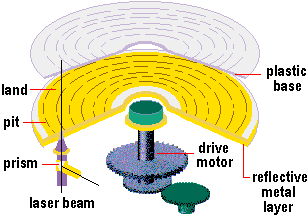The basic CD-ROM (Compact Disc – Read Only Memory) is 120mm in diameter and is basically a 1.2mm sandwich of three coatings: a back layer of clear polycarbonate plastic, a thin sheet of aluminium and a lacquer coating to protect the disc from external scratches and dust.
During the traditional mastering process, a polycarbonate plastic blank is stamped with millions of tiny indentations called pits – moulded in a spiral from the centre of the disc outwards – which is then coated with a thin layer of aluminium, giving the disc its characteristic silver colour. The pits are typically 0.5 microns wide, 0.83 to 3 microns long and 0.15 microns deep. The space between the tracks – the pitch – is just 1.6 microns. Track density is over 16,000 tpi, compared to 96tpi of a floppy disk and the average 400 of a hard disk. Unravelled and laid in a straight line the spiral of data would stretch for four miles.

Mechanically, the CD is less vulnerable than an analogue record, but that does not mean it should not be treated with care. It is not generally realised that it is the top printed layer of a CD that is the more vulnerable surface. Though the aluminium layer is protected from corrosion and damage by a lacquer on which a disc label can be printed, this protective layer is very thin – only 0.002mm. Careless treatment or granular dust can cause small scratches or hairline cracks, enabling air to penetrate and evaporate the aluminium coating and cause oxidising – rendering the disc unusable.
On the other surface, the laser actually focuses on a layer within the clear base and is able to see past small scratches, in much the same way a the human eye can focus on objects outside when looking through a window. Even if a scratch is serious enough to block the laser’s view, it will often be possible to polish it out.
- CD-ROM Red Book
- CD-ROM Yellow Book
- CD-ROM XA
- CD-ROM Green Book
- CD-ROM Orange Book
- CD-ROM White Book
- CD-ROM Blue Book
- CD-ROM Purple Book
- CD-ROM CD-I Bridge
- CD-ROM Photo CD
- CD-ROM File Systems
- CD-ROM Manufacturing
- CD-ROM The Disc
- CD-ROM Operations
- CD-ROM Digital Audio
- CD-ROM CLV
- CD-ROM CAV
- CD-ROM Applications
- CD-ROM Interfaces
- CD-ROM DMA vs. PIO Mode
- CD-ROM TrueX Technology